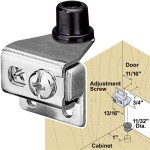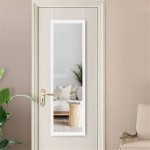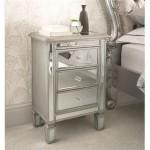How to Cover Large Mirrors Effectively
Large mirrors can present various challenges and needs that at times require covering. Whether prompted by a desire to change the aesthetic of a space, safeguard mirrors during renovations, protect children or pets from potential dangers, provide temporary privacy, or mitigate superstitious beliefs about mirrors reflecting negative energies, effectively covering a large mirror requires careful planning and execution.
This article details the methods, materials, and considerations necessary to address the task of covering large mirrors safely and effectively. It will cover short-term and long-term solutions, highlighting the pros and cons of various approaches, ensuring that individuals can protect their mirrors and adapt their environment to their needs.
Assessing the Need and Choosing the Right Method
Before embarking on the task of covering a large mirror, it is critical to thoroughly assess the specific need driving the decision. Understanding the duration for which the mirror needs to be covered, the desired level of opacity, and budget constraints will significantly influence the selection of the most suitable method. Temporary solutions, such as fabric drapes, are easily implemented if the mirror must be uncovered periodically or the covering is only required for a short duration. For instance, if a mirror is being covered solely to reduce glare during a midday meeting held in a room, a simple drape that is easily removed once the meeting concludes is more appropriate than a permanent or semi-permanent solution.
Conversely, if the intention is to cover the mirror for an extended period, such as throughout a remodeling project, then more durable and protective methods are advised. In these situations, the primary objective is to safeguard the mirror's surface from paint splatters, dust accumulation, and accidental impacts. Therefore, materials like heavy-duty plastic sheeting or padded blankets, carefully secured to the mirror's surface, provide a substantial barrier and guarantee the mirror remains undamaged during the construction.
Furthermore, if the purpose is to hide the mirror completely without removing it – say, for aesthetic reasons or beliefs pertaining to mirror reflections – then different considerations come into play. In this case, the goal is full opacity and a visually appealing covering that integrates with the room’s decor. Custom-made panels, decorative screens, or large canvas prints designed to fit directly over the mirror become viable options, offering both functionality and aesthetic value.
Privacy concerns also warrant a specific approach. If the mirror is located in a room used for private sessions or therapy, ensuring confidentiality is paramount. In this context, the chosen covering must not only obscure the reflection but also contribute to a sense of security and privacy for the occupants. Roller shades or blackout curtains that can be easily deployed and retracted offer a practical and versatile solution, providing instant privacy when needed and allowing the mirror to be revealed when desired.
Therefore, the selection of the most effective covering method hinges on a clear understanding of the underlying reason for covering the mirror, the projected duration of the covering, the desired level of protection or obscurity, and the overall aesthetic requirements of the space. These preliminary considerations are essential to ensure the chosen solution aligns seamlessly with the specific needs and objectives.
Materials and Tools for Covering Mirrors
The choice of materials and tools is dictated by the covering method selected. Different approaches necessitate specific items to ensure proper installation and a lasting, aesthetically pleasing result. For temporary fabric coverings, lightweight fabrics such as cotton or linen are suitable. These materials drape easily and are readily washable, making them convenient for short-term use. Securing the fabric can be achieved using simple methods such as adhesive hooks, decorative tacks, or even strategically placed furniture to hold the fabric in place. Precision is less crucial in this case, as the focus is on ease of use and removability.
For more robust protection during renovation or construction, heavy-duty plastic sheeting is an essential material. Opt for a mil thickness that is sufficient to withstand potential impacts and prevent tears. When applying plastic sheeting, masking tape is crucial for securing the edges to the mirror frame or the surrounding wall. Ensure the tape is of high quality and designed not to leave residue upon removal. Corner protectors, made of foam or plastic, are also recommended to protect the mirror's vulnerable edges from damage. In addition to plastic sheeting, thick blankets or padded furniture pads provide excellent impact resistance. These can be secured using packing tape or straps to ensure they remain firmly in place.
If the project involves constructing a custom-made panel or screen to conceal the mirror permanently or semi-permanently, the materials list expands significantly. Depending on the design, wood, metal, or composite materials may be used for the frame. Fabric, wallpaper, or even mirrored acrylic can then be applied to the panel's surface to create the desired aesthetic. Tools like saws, drills, sanders, and staplers are necessary for constructing the frame, while adhesives, paintbrushes, and measuring tools ensure a professional finish. In these instances, meticulous planning and precise measurements are crucial to achieving a seamless fit and a high-quality appearance.
Blackout curtains or roller shades require a different set of materials and tools. The curtains themselves should be made of a thick, opaque fabric that completely blocks light. The installation process typically involves mounting a curtain rod or roller shade mechanism above the mirror. This necessitates the use of a drill, screws, and possibly wall anchors, especially if the wall is made of drywall. Measuring tools are essential to ensure the curtain or shade is properly centered and covers the mirror completely. A level is also crucial to ensure the installation is straight and visually appealing.
Regardless of the method chosen, safety should always be a priority. When working with sharp tools or heavy materials, wearing appropriate safety gear, such as gloves and eye protection, is essential to prevent injuries. Additionally, when working at heights, a sturdy ladder or step stool should be used, and care should be taken to maintain balance and avoid falls.
Practical Application and Considerations
The practical application of covering a large mirror involves a methodical approach, considering various factors to ensure the covering remains secure and aesthetically pleasing. Proper preparation is a fundamental step. Before commencing the covering process, thoroughly clean the mirror’s surface to remove any dust, dirt, or fingerprints. This ensures that during long-term protection, the plastic or fabric doesn’t adhere to existing grime, and the mirror surface remains pristine underneath.
When using fabric, the method of attachment can significantly impact the overall look. Utilizing adhesive hooks offers a low-damage solution for hanging lightweight fabrics, allowing for easy removal later without harming the wall or mirror frame. Alternatively, decorative tacks can be employed for a more traditional aesthetic, though they will leave small holes. Always test the adhesive strength of any hook or tape on an inconspicuous area first to ensure it doesn't damage the surface. For fabric drapes, consider hemming the edges to prevent fraying and ensure a neat, professional appearance. This small detail can elevate the overall look and prevent the fabric from unraveling over time.
For long-term protection with plastic sheeting, meticulous attention to detail is essential. Overlap the plastic sheets generously to ensure complete coverage and prevent any gaps where dust or debris could penetrate. Secure the edges using high-quality masking tape, applying it firmly and smoothly to prevent air pockets. Regularly inspect the tape to ensure it hasn't loosened, especially during periods of temperature fluctuations or high humidity. If padding is being used in conjunction with plastic sheeting, layer the padding evenly over the mirror surface before applying the plastic. This provides an extra layer of protection against impacts. Consider using corner protectors, especially if the mirror has sharp or fragile edges, to further mitigate the risk of damage.
When installing custom-made panels or screens, precise measurements are essential to guarantee a seamless fit. Before commencing construction, create a detailed plan that includes the dimensions of the mirror, the desired thickness of the panel, and the type of mounting hardware to be used. Ensure the panel is securely mounted to the wall or mirror frame using appropriate anchors or brackets. If the panel is heavy, consider enlisting assistance to lift and position it safely. Regularly inspect the panel's mounting hardware to ensure it remains secure over time.
Blackout curtains or roller shades offer a versatile solution for concealing a mirror, providing instant privacy and light control. When selecting curtains, choose a fabric that is truly opaque and blocks light effectively. Consider the mounting hardware carefully, ensuring it is sturdy enough to support the weight of the curtains and withstand repeated use. When installing roller shades, ensure the mechanism is properly aligned and the shade operates smoothly. Regularly clean the curtains or shades to prevent dust accumulation and maintain their appearance.
Ultimately, the effectiveness of any mirror covering solution lies in the attention to detail during its installation and the ongoing maintenance to ensure its longevity and aesthetic appeal. Regularly inspect the covering, regardless of type, to identify and address any potential issues promptly.

How To Cover Redo A Large Wall Mirror Hometalk

3 Ways To Cover Mirrored Walls Wikihow

3 Ways To Cover Mirrored Walls Wikihow

3 Ways To Cover Mirrored Walls Wikihow

3 Ways To Cover Mirrored Walls Wikihow

3 Ways To Cover Mirrored Walls Wikihow

How To Cover Redo A Large Wall Mirror Decor Living Room

Modernizing A Mirrored Wall Tape To The Rescue Average But Inspired

3 Ways To Cover Mirrored Walls Wikihow

Mirror Decoration For Home 15 Ideas To Decorate With Mirrors








